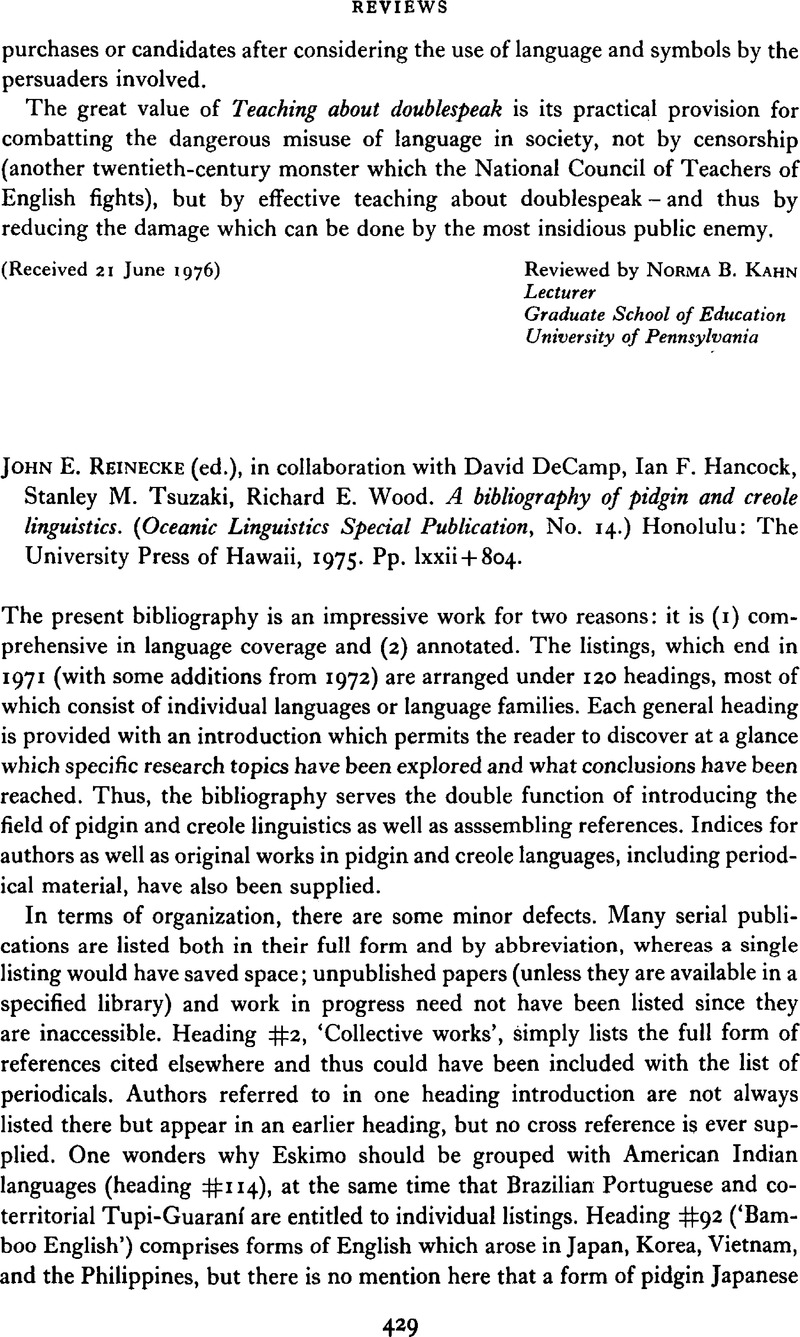No CrossRef data available.
Article contents
John E. Reinecke (ed.), in collaboration with David DeCamp, Ian F. Hancock, Stanley M. Tsuzaki Richard E. Wood. A bibliography of pidgin and creole linguistics. (Oceanic Linguistics Special Publication, No. 14.) Honolulu: The University Press of Hawaii, Pp. lxxii + 804.
Published online by Cambridge University Press: 18 December 2008
Abstract
An abstract is not available for this content so a preview has been provided. Please use the Get access link above for information on how to access this content.

- Type
- Book Review
- Information
- Copyright
- Copyright © Cambridge University Press 1977
References
REFERENCES
Belic, J. (1972). Zur Problematik der Grenzen zw. verwandten Sprachen dargestellt am Material slavischer Sprachen. Wissenschaftliche Zeitschrift Karl-Marx- Universität (Leipzig), Gesells- und Sprachwissenschaftliche Reihe 14. 105–10.Google Scholar
Dolgopol'skij, A. B. (1955) Protiv osibocnoj koncepcii ‘gibridnyx’ jazykov (o kreol'skix narecijaz). Grammaticeskij stroj (Ucenye zapiski Mosk. Gos. Fed. Inst. Inostrannyx Jazykov, 7.) (Moscow), 29–60.Google Scholar
Hancock, I. F. (1971). A map and list of pidgin and creole languages. In Hymes, D. (ed.) Pidginization and creolization of languages. Cambridge: Cambridge University Press.Google Scholar
Hymes, D. (ed.) (1971) Introduction, Part III, Pidginization and creolization of languages. Cambridge: Cambridge University Press.Google Scholar
Navarro, Tomás T. (1953). Observaciones sobre el Papiamento. Nueva Revista de Filologla Hispánica 7. 183–9.CrossRefGoogle Scholar
Reinecke, J. E. (1938). Trade jargons and creole dialects as marginal languages. Social Farces 17. 107–18;CrossRefGoogle Scholar
reprinted in Hymes, D. (ed.) (1964) Language in culture and society. New York: Harper & Row, 534–46.Google Scholar
Rūke-Dravina, V. (1966). Isoglossen und Sprachgrenzen. Acta Baltico-Slavica 3. 159–70.Google Scholar
Sala, M. (1971). Phonétique et phonologie du judéo-espagnol de Bucarest. The Hague-Paris: Mouton.CrossRefGoogle Scholar
Schultze, E. (1933). Sklaven- und Dienersprachen (sogen. Handelssprachen), em Beitrag zur Sprache- und Wanderungssoziologie. Sociologus 9. 377–418.Google Scholar
Serech, J. (1943) Zur Frage der ukrainisch-weissruthenischen Sprachgrenze. Orbis 2. 40–8.Google Scholar
Stieber, Z. (1938). Sposoby powstawania slowiasiskich gwar przejiciowych. Krakow: Polska Akademia Umiejctności.Google Scholar
Stieber, Z. (1962). O stownictwie pogranicznych dialektów jezyków slowiańskich. Slavica Pragensia 4. 611–14.Google Scholar




